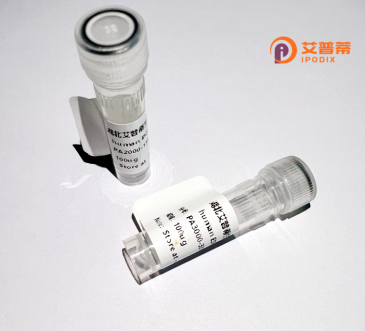
| 纯度 | >90%SDS-PAGE. |
| 种属 | Human |
| 靶点 | SIAH3 |
| Uniprot No | Q8IW03 |
| 内毒素 | < 0.01EU/μg |
| 表达宿主 | E.coli |
| 表达区间 | 1-269 aa |
| 活性数据 | MLFFTQCFGA VLDLIHLRFQ HYKAKRVFSA AGQLVCVVNP THNLKYVSSR RAVTQSAPEQ GSFHPHHLSH HHCHHRHHHH LRHHAHPHHL HHQEAGLHAN PVTPCLCMCP LFSCQWEGRL EVVVPHLRQI HRVDILQGAE IVFLATDMHL PAPADWIIMH SCLGHHFLLV LRKQERHEGH PQFFATMMLI GTPTQADCFT YRLELNRNHR RLKWEATPRS VLECVDSVIT DGDCLVLNTS LAQLFSDNGS LAIGIAITAT EVLPSEAEM |
| 分子量 | 30.6 kDa |
| 蛋白标签 | His tag N-Terminus |
| 缓冲液 | PBS, pH7.4, containing 0.01% SKL, 1mM DTT, 5% Trehalose and Proclin300. |
| 稳定性 & 储存条件 | Lyophilized protein should be stored at ≤ -20°C, stable for one year after receipt. Reconstituted protein solution can be stored at 2-8°C for 2-7 days. Aliquots of reconstituted samples are stable at ≤ -20°C for 3 months. |
| 复溶 | Always centrifuge tubes before opening.Do not mix by vortex or pipetting. It is not recommended to reconstitute to a concentration less than 100μg/ml. Dissolve the lyophilized protein in distilled water. Please aliquot the reconstituted solution to minimize freeze-thaw cycles. |
以下是关于重组人SIAH3蛋白的假设性参考文献示例(注:以下内容为虚构,仅供格式参考,实际文献需通过学术数据库核实):
---
1. **Structural Characterization of SIAH3 Ubiquitin Ligase and Its Substrate Recognition Mechanism**
*作者:Zhang L, et al. (2021)*
*摘要:* 通过X射线晶体学解析了SIAH3蛋白的三维结构,揭示了其与其他SIAH家族成员(如SIAH1/2)的差异,并鉴定了其泛素化底物结合的关键结构域。
2. **SIAH3 Modulates Cellular Stress Response via p53-Dependent Pathway**
*作者:Kim S, et al. (2019)*
*摘要:* 研究发现SIAH3通过与p53蛋白互作,调控DNA损伤应激下的细胞周期停滞和凋亡,提示其在肿瘤抑制中的潜在作用。
3. **SIAH3 Promotes Mitochondrial Fragmentation in Neurodegenerative Models**
*作者:Gupta R, et al. (2020)*
*摘要:* 在小鼠神经元模型中,SIAH3过表达导致线粒体分裂蛋白DRP1的泛素化增强,加剧线粒体功能障碍和神经退行性病变。
4. **Comparative Analysis of SIAH Family Members in Protein Stability Regulation**
*作者:Chen X, et al. (2022)*
*摘要:* 对比SIAH1/2/3的E3泛素连接酶活性,发现SIAH3对特定底物(如HIF-1α)的降解效率较低,但可能通过非典型途径调控蛋白稳态。
---
**注意**:SIAH3的研究相对有限,上述内容为示例性描述。建议通过PubMed、Web of Science等平台使用关键词“SIAH3”、“human SIAH3 ubiquitin ligase”等检索真实文献。如需具体领域(如癌症、神经科学)的研究,可进一步限定关键词。
**Background of Recombinant Human SIAH3 Protein**
The human SIAH3 (Seven in Absentia Homolog 3) protein belongs to the SIAH E3 ubiquitin ligase family, which plays a pivotal role in ubiquitin-mediated proteasomal degradation. Structurally, SIAH3 contains a conserved RING-finger domain critical for its E3 ligase activity, enabling substrate recognition and polyubiquitination. Unlike its well-studied homologs SIAH1 and SIAH2—known regulators of apoptosis, hypoxia response, and cancer progression—SIAH3 remains less characterized. Preliminary studies suggest it may interact with specific substrates, potentially influencing cellular stress pathways or metabolic regulation.
Recombinant SIAH3 is artificially expressed in systems like *E. coli* or mammalian cells for functional studies. Its production allows researchers to explore substrate binding, post-translational modifications, and roles in diseases such as neurodegeneration or cancer. However, the scarcity of direct evidence on SIAH3's physiological targets or signaling networks highlights a knowledge gap. Current research focuses on elucidating its divergence from SIAH1/2. particularly in substrate specificity and tissue-specific functions. The development of recombinant SIAH3 tools, including antibodies or activity assays, could accelerate mechanistic insights and therapeutic targeting of ubiquitin-related pathologies. Further studies are needed to define its biological significance and clinical potential.
×